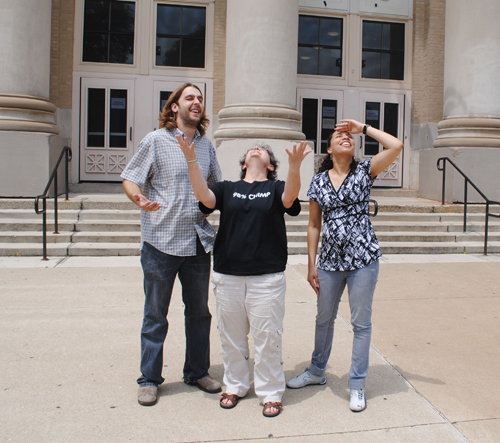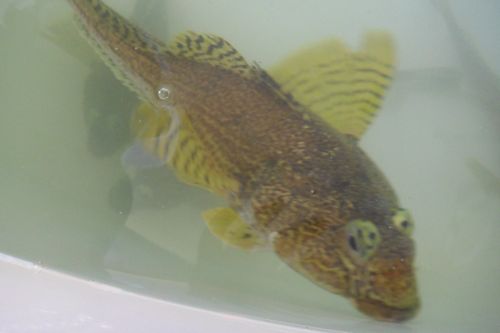How ironic that my last journal is on the Summer Solstice after spending 2 months in the Antarctic winter! The sun feels great!! (What the solstice means is a great thing to look up and find out why this is the longest day of the year, by the way.)
 Two of my fellow teachers, Andy Long and RyAnn Nelson-Jaiyesimi, join me in soaking up some summer sun. I got back in time to catch some of my co workers, but the students were already out enjoying summer break. Guess I'll have to wait until August to see them.
Two of my fellow teachers, Andy Long and RyAnn Nelson-Jaiyesimi, join me in soaking up some summer sun. I got back in time to catch some of my co workers, but the students were already out enjoying summer break. Guess I'll have to wait until August to see them.
But let's get to what you have all been waiting for...breaking news about the icefishes. To recap, we have been studying thermal tolerance among Antarctic fishes - this includes red and white-blooded fishes. We used Notothenia coriiceps as our red-blooded fish. They are a very prevalent fish down here and inhabit the same waters as the icefishes. The red-blooded fishes, such as the coriiceps are more active and tend to live a bit higher in the water column than the icesfishes we caught. We used Chaenocephalus aceratus as our icefish species. Small wonder that these guys are not as active when you look at them. Very large heads in relation to their bodies. So if you remember, cold water has more dissolved oxygen (DO) in it than warm water, the kind of water that the fish can use to obtain oxygen. AND the area around the Western Antarctic Peninsula is one of the primary places on the planet that is warming up more noticeably.
 The Chaenocephalus aceratus, a species of ice fish, were so intriguing to see. Very prehistoric looking in some ways. Very beautiful. Photo courtesy of Jody Beers.
The Chaenocephalus aceratus, a species of ice fish, were so intriguing to see. Very prehistoric looking in some ways. Very beautiful. Photo courtesy of Jody Beers.
So, our question - will the icefishes, who have no hemoglobin, be better able to tolerate the warming waters if more oxygen is present? And the answer that we found was...Wait. First what do you think? And more importantly Why do you think that? It's always good to have a rationale (reason) for your hypothesis. Sometimes it might be a complete guess, but always try to think through the possibilities before making a hypothesis.
 Kristin is inserting a canula into this *coriiceps*. Devin sutured it in. I was held a stream of running water over its gills so that the fish would have access to oxygen while out of water.
Kristin is inserting a canula into this *coriiceps*. Devin sutured it in. I was held a stream of running water over its gills so that the fish would have access to oxygen while out of water.
Our results were really interesting, not least of which because the amount of O2 did not seem to make much difference with the icefish but it made some difference with the red-blooded fish. The icefish had the same critical CTMax under hyperoxic conditions (i.e., when there was more O2 available) than under normoxia (typical oxygen concentrations). Do you remember what CTMax is? The Critical Thermal Maximum - the highest temperature that the fish can tolerate and be able to "right itself" (stay upright and not fall over or go belly up). So the CTMAX remained the same for the icefish, though the CTMax for the coriiceps, the fish with hemoglobin, did increase. What? This was not expected at all, which makes it even more intriguing. What does this mean? The results suggest that for the icefish something else is determining the CTMax besides oxygen levels.
 This is the Gobionotothen gibberifrons, also known as the Gibby. It is a red blooded Antarctic fish.
This is the Gobionotothen gibberifrons, also known as the Gibby. It is a red blooded Antarctic fish.
 The Notothenia *coriiceps* was the primary red-blooded, Antarctic fish that we used in our research. Photo courtesy of Kristin O'Brien.
The Notothenia *coriiceps* was the primary red-blooded, Antarctic fish that we used in our research. Photo courtesy of Kristin O'Brien.
Kristin, Lisa, Devin, and Irina will be taking a lot of samples back to analyze. They will be looking at the amount of lactic acid in the tissues. Lactic acid is produced in a cell when it goes through cellular respiration without oxygen. They will look at something called Hypoxia Inducing Factor (HIF) - hypoxia - lack of oxygen. HIF is a transcription factor - something that binds to genes and regulates gene expression, in this case under conditions of low oxygen. There are a lot of questions to answer. As some of you may know, proteins can be greatly affected by heat (remember the enzyme labs and the denatured enzymes, which are proteins) so maybe certain proteins cease to function. This analysis should be really interesting and will certainly keep Kristin and Lisa busy for quite some time. I plan to keep plugged in to their work as well. So give this some thought and make your own hypothesis as to what is going on. I'm sure you'll be hearing more about all of this...if you look for it.
As usual, we are left with more questions to investigate. Are you seeing a theme here? Investigate, experiment, discover, new questions arise, investigate, experiment, discover, new questions arise, investigate. Whoa. Enough. I think you have the idea.
Some final thoughts, words, and a thank you
And so this brings us to the end of this trip. I want you all to know that I really enjoyed your comments, your questions, and your company. I loved hearing your feedback and thoughts concerning these journals and I had fun keeping you all posted and informed. Hopefully, some of you out there are looking at science in a new light or have found something to spark your interest and pursue in more depth. You can always send me a note, ask me a question, or let me know your favorite parts of the expedition to my email at my school - Lindblom Math and Science Academy or at pmdell [at] cps.edu.
A huge thank you to Kristin and Lisa who brought me along on their expedition and to those folks working down at Palmer Station...and of course, PolarTREC.
Hopefully these journals have helped you develop a deeper respect for the necessity and vast nature of scientific exploration. This may also include those who were among the first to travel down to the Antarctic continent and explore it before there were any comfortable stations. Some of them lost their lives in their quest to expand the bounds of our knowledge of the world we live in. Many suffered great hardships doing so. But that is true of many trailblazers of all kinds. So here's to the men and women who push the boundaries, take those risks, and in the process, expand our knowledge and horizons. And here's to science in all of its many facets!! Now, I do believe it is high time to get out there and enjoy the Chicago summer!
Ciao!
 Check out the greenery! Quite a bit different from the last two months. See you at the beach...Enjoy your summer!
Check out the greenery! Quite a bit different from the last two months. See you at the beach...Enjoy your summer!
